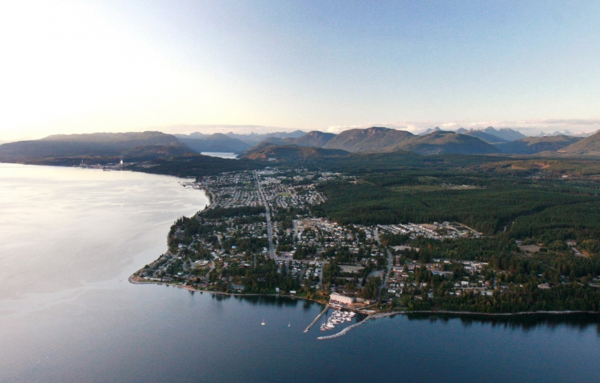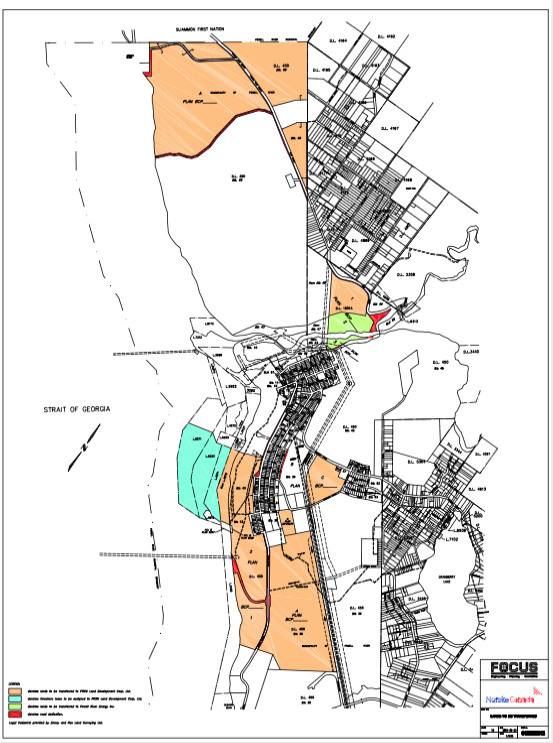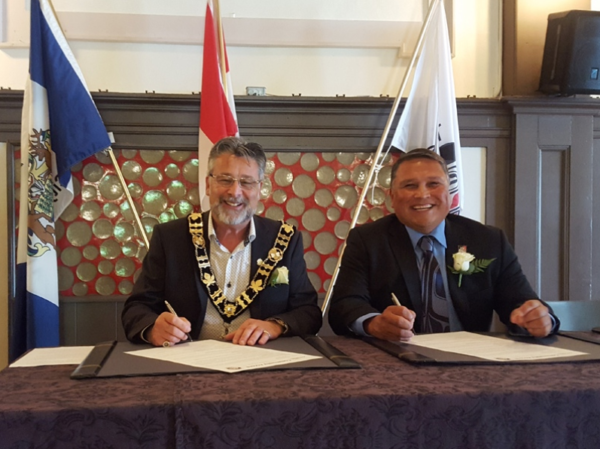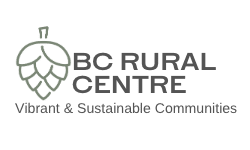
Tla’amin Nation & Powell River: Government to Government Collaboration on BC’s Sunshine Coast

The coastal town of Powell River shares several similarities with other rural communities in BC. Powell River was established and grew next to a historical First Nations community – in this case on the traditional territory of the Tla’amin Nation. Its economic growth and expansion was primarily due to a heavy reliance on the forest industry. And the community has experienced significant economic and employment transitional issues related to its major forest sector employer – a pulp and paper mill. However, as described below, Powell River is also quite unique in terms of the level of partnership and collaboration between the municipal government and the Tla’amin Nation. The strongly proactive approach Powell River and the Tla’amin Nation have taken to manage the development and transition of their communities and economy is well worth examining.
Background

Located on the traditional territory of the Tla’amin (formerly known as Sliammon) Nation, Powell River is situated at the north end of what is commonly called the Sunshine Coast, approximately 130 kilometres north of Vancouver. Like many rural BC communities, Powell River is somewhat isolated — landlocked as it is, a ferry is required to reach or leave the town. As of 2019, the regional population was approximately 21,358, of which 13,874 live in the City of Powell River and approximately 1,100 in the Tla’amin village of Sliammon.

Tla’amin Nation is one of 20 Coast Salish tribes inhabiting the southern coastal region of BC. In 1879, the federal government reduced the Tla’amins’ traditional territory and created six small reserves – including Sliammon, the current major Tla’amin village, located 12 kilometres north of the original Tla’amin community at the mouth of the Powell River.
In 1909, after forcing the Tla’amin off their land, the federal government granted land at the mouth of the Powell River to the Powell River Paper Company to build a pulp and paper mill. The community quickly grew around the mill site as the first rolls of paper were produced in 1910. The Powell River mill eventually grew to become one of the largest pulp and paper mills in the world.
Up until the late 1990s, Powell River was quite prosperous – although this economic wealth did not extend to the Tla’amin. Though the two settlements were only 12 kilometres apart, there was little formal collaboration. This all changed as a result of two major issues that arose in 2002 and 2003.
From Conflict to Collaboration
In 2002, the City of Powell River began constructing a seawall walkway. However, the city had not shared its plans with the Tla’amin, and thus were not aware of significant First Nations cultural sites along the proposed route. Then-Chief Maynard Harry and Tla’amin elders confronted city government with their concerns about the project. Fortunately, Powell River’s mayor quickly acknowledged the city’s mistake, apologized, and invited the Tla’amin to work collaboratively on the project. With a new partnership forged between Tla’amin and the municipal government, additional funding was secured, and the Tla’amin successfully managed the completion of the project.
Community Accords & Protocol Agreements
This experience, of moving from conflict to successful project collaboration, led both the municipal government and Tla’amin to recognize of the need for, and benefits of, closer communications and meaningful consultations on an ongoing basis. As a result, in May of 2003, the city and Sliammon signed a community accord and protocol agreement. The accord explicitly recognized that, “….the interests of all persons living in the two communities are best served by working together in the spirit of cooperation.” To achieve this, the two governments agreed to, “…meet regularly to promote and encourage open and constructive dialogue.” They also agreed to, “…explore and initiate activities designed to facilitate economic diversification, to protect cultural heritage resources, to promote community growth, to increase investment and to generate employment.”
In June 2004, an additional protocol agreement on culture, heritage and economic development was signed between the Sliammon and the City of Powell River, to ensure and guide reciprocal review of each government’s plans for lands within the municipal boundary.
Building on the Community Accord, in December of 2004 a Protocol Agreement for Communication and Cooperation was also signed by the Sliammon and the Powell River Regional District. (See Appendix for a full presentation on how the Community Accord came together. The Accord was refreshed on the occasion of its 15th anniversary, in 2018).
Creation of the Joint Venture
The early 2000s saw major economic challenges and transitions in BC’s coastal pulp and paper sector, with several mills at risk of closure. Powell River’s pulp and paper mill at its peak employed 2,500 workers, but by 2003, the workforce had declined to less than 800. However, the company and mill were still providing nearly 70 percent of the city’s total property tax revenue.
Facing significant financial challenges the mill’s owner, NorskeCanada, began looking for ways to reduce operational costs and generate additional revenue. As a result, in 2003 the company began contemplating selling a 325 hectare (803 acre) parcel of various properties within the municipal boundaries, surplus to its needs. It was generally recognized this parcel included some very strategic and valuable pieces of property, in a city with a limited inventory of developable land within its boundaries. Thus both the municipality and the Sliammon were interested in talking with NorskeCanada, an interest fuelled in part by a fear the lands might be sold to an external buyer, causing both communities to lose influence over how the lands were developed.
Sliammon had already initiated discussions with NorskeCanada, and the parties agreed to bring the city into talks about a potential purchase of the land. As the major property tax payer in Powell River, NorskeCanada had a vested interest in seeing expanded economic development, in order to increase and diversify the city’s tax base.
In 2004, NorskeCanada turned down other purchase offers and signed a Memorandum of Understanding with the Sliammon (now Tla’amin) First Nation and the City of Powell River. After two years of discussion and negotiation, in 2006 the three parties announced the formation of the PRSC Limited Partnership as a three-way joint venture between the City of Powell River (thru the PR Waterfront Development Corporation), Sliammon First Nation (through Tee’skwat Land Holdings Ltd.), and Catalyst Paper Corporation (the new owners of the mill). Catalyst sold PRSC Ltd the 325 ha parcel of land for $4.5 million, and provided PRSC Ltd with a mortgage of $4.5 million at a five percent interest rate. It was agreed the mortgage would be reduced as parcels of land were sold off. Each party contributed $50,000 in operating funds for the managing partner — PRSC Land Developments Ltd.

PRSC’s original properties in orange
The day-to-day management of the PRSC land inventory was jointly administered by the city’s manager of economic development and the manager of the Sliammon Development Corporation. Between 2006 and 2011, approximately 3 out of the 8 properties were sold for a variety of developments including housing developments and commercial farming. While $1.5 million in mortgage payments were made over that time period, only $200,000 went toward the principal, leaving an outstanding mortgage balance of $4.3 Million.
While under Creditor Protection in 2012, Catalyst Paper entered into an agreement with PRWDC and Tees’kwat Land Holdings Ltd (TLH) to sell its shares and retire the mortgage for the sum of $3.0 million dollars (forgiving Interest owed). The cost of the transaction was jointly paid by PRWDC, TLH and Tla’amin Nation. The share transfer and mortgage retirement were completed in September 2014 and the PRSCLP was restructured to include the following shareholders:
- PRWDC – 50% ownership
- Tla’amin Nation – 25% ownership
- Tees’kwat Land Holdings – 25% ownership
In September 2017 the Directors representing Tla’amin on the PRSC Land Developments Ltd proposed that the shareholders discuss taking ownership of the remaining properties and dissolve the Limited Partnership and its managing partner. After an appraisal of the properties and several meetings (including a public government to government meeting in April 2018), the PRSCLP Board agreed to execute a shareholder draw and dissolve the partnership.
The dissolution of PRSC Limited Partnership and PRSC Land Developments Ltd were finalized in December 2018 with property ownership distributed as follows:
- Tla’amin Nation: 245.6 acres appraised at $2.17 million: Lot A, District Lot 450, Group 1, New Westminster District, Plan BCP23890.
- Powell River Waterfront Development Corporation: 182 acres appraised at $2.16 million Lot 2, District Lot 450, Group 1, New Westminster District, Plan BCP23888 Except Part on Plan EPP68945 (80 acres); and Block 56, District Lot 450, Plan 8096, Except Plans 12767 and BCP46067 (102 acres).
The table below shows the disposition of the total PRSC Ltd land inventory.
Table 1: Disposition of PRSC Ltd. Land Holdings
| Parcel | Size (acres) | Use (or proposed use) of the Lands Being Sold |
| Lot A | 132 | Sold – Purchased by the City for strategic development purposes |
| Lot 1 | 34.1 | Sold – Creation of Lower Millennium Waterfront Park |
| Lot B | 7.9 | Sold -New 40 lot residential subdivision |
| Lot C | 31.6 | Sold -In Agriculture Land Reserve, now site of an operating farm. |
| Lot 1 | 30.6 | Sold to a developer who is pursuing a resort development |
| Lot A | 245.6 | Transferred to Tla’amin Nation |
| Block 56 | 100 | Transferred to City of Powell River |
| Lot 2, District Lot 450, | 80 acres | Transferred to the City of Powell River |
| DL4070 | 18 acres of Marine Industrial | Evenly split between the City and Tla’amin. Provided Tla’amin with the opportunity to establish a log dump and sort for its forestry operations and the City land to construct its new consolidated liquid waste treatment plant to comply with provincial and federal regulations. |
Both Tla’amin and Powell River feel the PRSC Limited partnership was a success as the two communities were able to wrest control of the Paper Mill’s surplus properties for future development. Before discussions were launched to form a partnership between the three parties in 2004, NorskeCanada was negotiating deals to sell the properties to outside interests with no guarantees they were ever going to be developed. If this were to happen future development in the region would stagnate. In forming the PRSC Limited Partnership, Tla’amin and the City were eventually able to secure ownership of the properties for the benefit of both communities.
The Limited Partnership also helped to deepen the relationship between Tla’amin and the City as prior to the final transfer of the remaining properties Mayor and Council consented to the properties owned by Tla’amin inside the municipality be designated as Treaty Settlement Lands. This is the first time in the history of BC that a municipality has agreed to such a measure.
An Innovative Municipal – Industry Service Agreement
During this same period, Catalyst was also seeking significant industrial property taxation relief from the various coastal communities that their mills were located in – including Powell River. Recognizing the significant financial operating and revenue challenges that Catalyst was experiencing the mayor and council met with Catalyst to discuss options. Determined to help keep the paper mill operating as long as possible, the city was very proactive in looking for ways to help the mill remain financially viable. This led to a rather unique win-win service agreement between the city and Catalyst Paper. Under a 20 year service agreement, the city pays Catalyst in order to use the mill’s effluent system to treat Powell River’s liquid waste, and to burn the city’s bio-solids in the mill’s waste wood boiler. This agreement provides both parties with a financial win.
Current Initiatives & Local Control over Economic Development
The strong collaboration and partnership between Tla’amin, the City of Powell River, and the Powell River Regional District has grown and continues to this day.
Tla’amin Treaty & Self Government
In April 2016, the Tla’amin Nation endorsed a final treaty agreement with Canada and BC. As part of the treaty settlement, Tla’amin received a cash settlement, 8,323 hectares of land, and a 50-year resource revenue sharing agreement. The land settlement means Tla’amin have direct control over and management of a significant portion of land in and around Powell River. Indeed, as another testament to the strength of their relationship, the city agreed to portions of Crown lands within its municipal boundaries to be part of the treaty settlement lands – a first for a BC municipality.
This is a first for British Columbia. No other municipality has consented to having lands designated as Treaty Settlement Lands (TSL) within their boundaries at the request of an indigenous nation.
Mayor Dave Formosa, in the Powell River Peak, October 17, 2018
Control over Forestry Lands
Tla’amin and Powell River have also worked to secure local influence and control over forestry management on Crown lands in the region, to ensure greater local benefit. Tla’amin currently holds three different forest licenses, with a combined annual allowable cut of 53,000 cubic metres. In 2006, Powell River was awarded a community forest agreement, with a current annual allowable cut of 35,000 cubic metres. Both Tla’amin’s and the city’s forest licenses have created significant local employment and economic benefits for the local economy. From its inception in 2007, to May of 2017, the Powell River Community Forest was able to place over $10.6 million in operating profits into its reserve fund.
Community Planning & Service Agreements
Tla’amin and Powell River have continued to build on that first community accord, signed in 2003. In addition to the initiatives discussed above, the city & Tla’amin have undertaken several other joint initiatives. In 2009, a service agreement was signed to share fire protection and library services. In 2011, local BC Transit service was expanded to service the community of Sliammon. The two governments are now negotiating agreements to secure funding for a liquid waste management plant, and a jointly funded social planning position. Collaboration and cooperation between the two levels of government will become increasingly important as land development continues to occur in the region. There are quarterly joint meetings of the Tla’amin and Powell River councils to share information, so each government is aware of what the other is working on. At a staff level, the chief administrative officers of the city, the First Nation, and the regional district meet monthly.
To formally acknowledge and recognize the continued importance of their collaboration, in July 2018, Tla’amin and the City of Powell River re-signed their community accord.

CONCLUSION
In some respects, the situation at the northern edge of the Sunshine Coast is a familiar one — two communities, one indigenous, one settler — living adjacent to each other, but with little historical cooperation or interaction. And in the case of Powell River, like many rural BC communities, the city has seen its share of significant changes and challenges to its resource-based economy.
However, the story here is also unique in many ways.
The original community accord signed by Sliammon/Tla’amin and Powell River in 2003 was in many respects ground-breaking, predating more recent recognition of the need for reconciliation and community to community agreements in the province. The development and signing of that original accord created the spirit of mutual respect and cooperation required to enable the two governments to formally collaborate and partner on various initiatives and projects. Indeed, mutual respect and a strong desire for partnership led the Powell River Regional District to accept the gift of a name from Tla’amin elders. In 2018, the Powell River Regional District formally changed its name to the qathet Regional District. For the Tla’amin, the word qathet means ‘working together’.
We want to stimulate the economy of Powell River because if it is busier and happening there, it is good for us too. If we create a business here [on Tla’amin lands], we live in such a small community that our client base will include everyone in Powell River.
Hegus Clint Williams, in Powell River Living, November 2015.
Appendix
For a joint presentation on how the details of the Powell River – Tla’amin Community Accord came together, click on the cover below:
For a downloadable PDF version of this report, click on the cover below.
For more information on government to government relations, visit our First Nations/Local Government Partnerships page.


